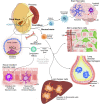How cell migration helps immune sentinels
- PMID: 36268510
- PMCID: PMC9577558
- DOI: 10.3389/fcell.2022.932472
How cell migration helps immune sentinels
Abstract
The immune system relies on the migratory capacity of its cellular components, which must be mobile in order to defend the host from invading micro-organisms or malignant cells. This applies in particular to immune sentinels from the myeloid lineage, i.e. macrophages and dendritic cells. Cell migration is already at work during mammalian early development, when myeloid cell precursors migrate from the yolk sac, an extra embryonic structure, to colonize tissues and form the pool of tissue-resident macrophages. Later, this is accompanied by a migration wave of precursors and monocytes from the bone marrow to secondary lymphoid organs and the peripheral tissues. They differentiate into DCs and monocyte-derived macrophages. During adult life, cell migration endows immune cells with the ability to patrol their environment as well as to circulate between peripheral tissues and lymphoid organs. Hence migration of immune cells is key to building an efficient defense system for an organism. In this review, we will describe how cell migratory capacity regulates the various stages in the life of myeloid cells from development to tissue patrolling, and migration to lymph nodes. We will focus on the role of the actin cytoskeletal machinery and its regulators, and how it contributes to the establishment and function of the immune system.
Keywords: actin; ameboid motility; cell migration; cytoskeleton; dendritic cell; myeloid cells; tissue-resident macrophage.
Copyright © 2022 Delgado and Lennon-Duménil.
Conflict of interest statement
The authors declare that the research was conducted in the absence of any commercial or financial relationships that could be construed as a potential conflict of interest.
Figures

References
-
- Alraies Z., Rivera C. A., Delgado M-G. (2022). Mechanical stimulation shapes the immunoregulatory properties of dendritic cells. bioRxiv 2022, 503223. 10.1101/2022.08.09.503223 - DOI
Publication types
LinkOut - more resources
Full Text Sources

